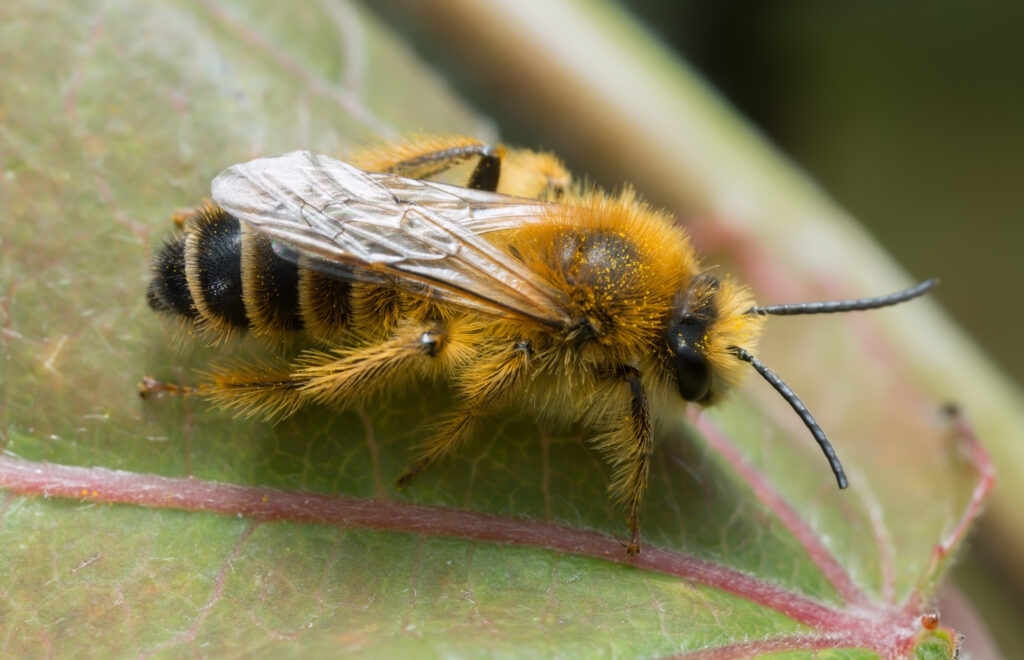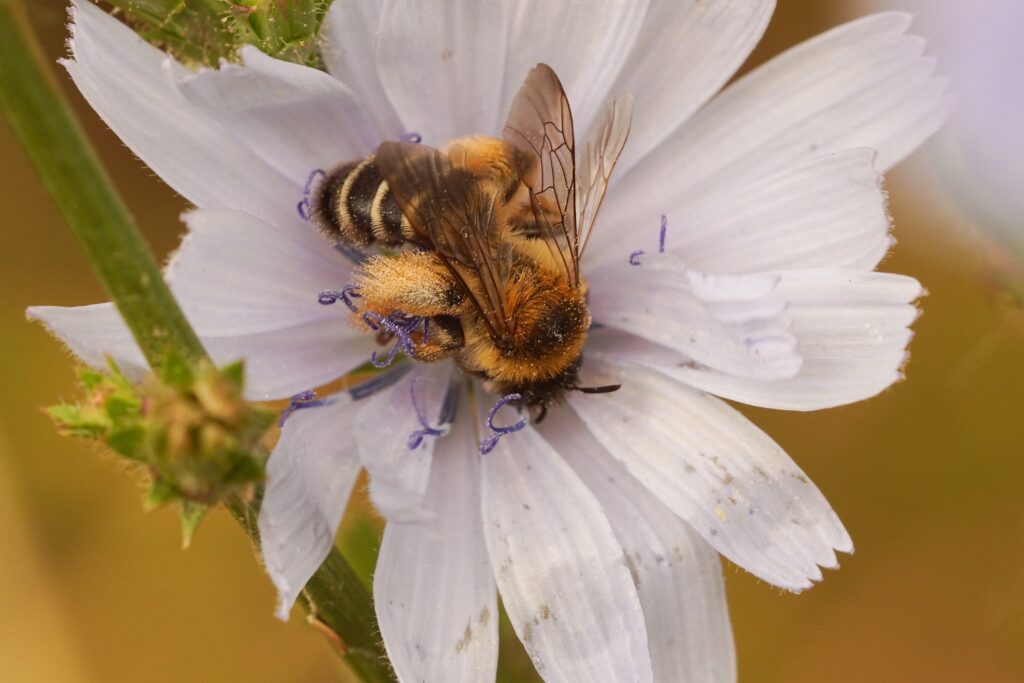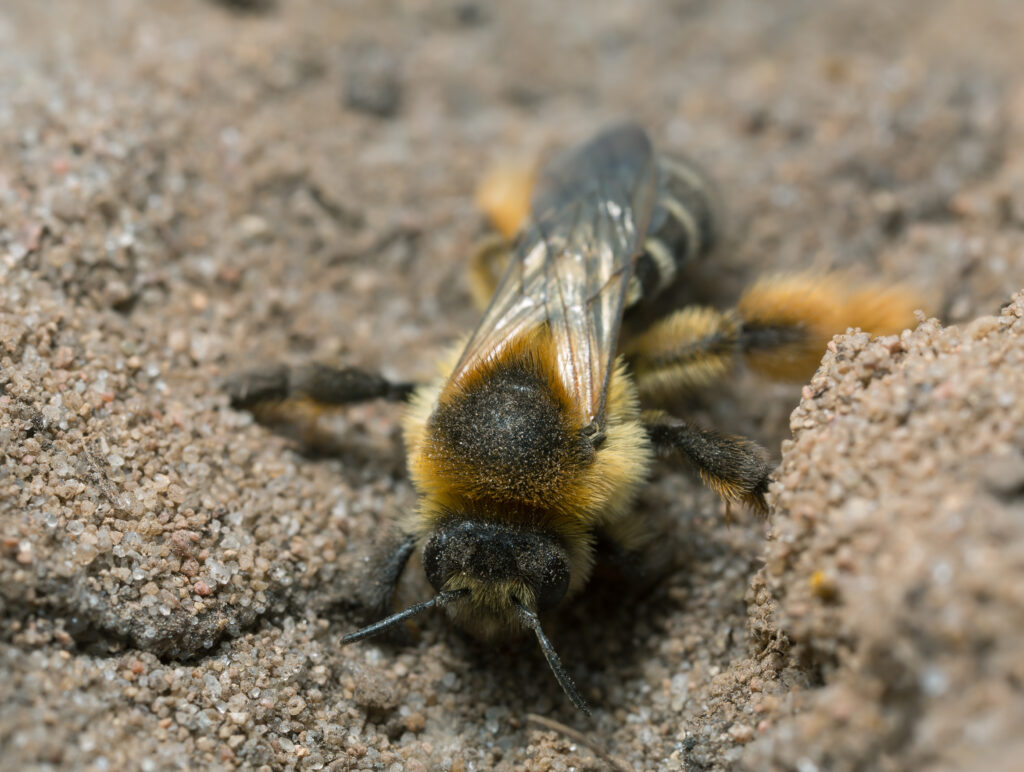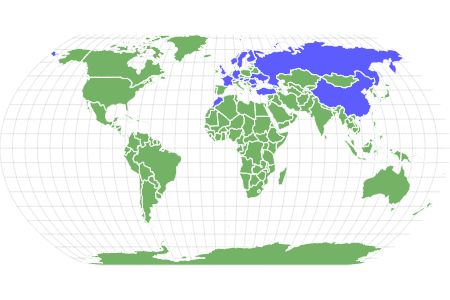Pantaloon Bee
Dasypoda hirtipes
In Russia there is an aggregate of pantaloon bee nests containing over 7 million pantaloon bees!
Advertisement
Pantaloon Bee Scientific Classification
- Kingdom
- Animalia
- Order
- Hymenoptera
- Family
- Melittidae
- Genus
- Dasypoda
- Scientific Name
- Dasypoda hirtipes
Read our Complete Guide to Classification of Animals.
Pantaloon Bee Conservation Status
Pantaloon Bee Facts
- Prey
- N/A
- Main Prey
- N/A
- Name Of Young
- larvae
- Group Behavior
- Solitary
- Fun Fact
- In Russia there is an aggregate of pantaloon bee nests containing over 7 million pantaloon bees!
- Estimated Population Size
- Undetermined
- Biggest Threat
- habitat loss, pesticide
- Most Distinctive Feature
- densely hairy legs in females
- Distinctive Feature
- overall a very attractive bee
- Other Name(s)
- hairy-legged mining bee
- Gestation Period
- N/A
- Temperament
- mild
- Wingspan
- 0.5 - 0.75 inches (12-19 mm).
- Training
- N/A
- Optimum pH Level
- N/A
- Incubation Period
- 5-7 days
- Age Of Independence
- at emergence
- Age Of Fledgling
- at emergence
- Average Spawn Size
- 1-28 eggs
- Litter Size
- N/A
- Habitat
- sandy, loamy soil with access to forage
- Predators
- birds, spiders, wasps, small mammals
- Diet
- Herbivore
- Average Litter Size
- N/A
- Lifestyle
- Diurnal
- Favorite Food
- Nectar
- Type
- Dasypoda hirtipes
- Common Name
- Pantaloon bee
- Special Features
- hairy legs
- Origin
- Europe
- Number Of Species
- 95
- Location
- Eurasia
- Slogan
- N/A
- Group
- N/A
- Nesting Location
- subterranean burrows
- Age of Molting
- various times during larval stage
Pantaloon Bee Physical Characteristics
- Color
- Brown
- Yellow
- Fawn
- Black
- Gold
- Dark Brown
- Cream
- Orange
- Skin Type
- Exoskeleton
- Lifespan
- 3 weeks - 1 year
- Weight
- less than 1 ounce
- Height
- 0.1-0.3 inches
- Length
- 0.43- 0.62 inches (11 to 16 mm)
- Age of Sexual Maturity
- 1 day post emergence
- Age of Weaning
- N/A
- Venomous
- No
- Aggression
- Low
View all of the Pantaloon Bee images!
In the bustling world of bees, Dasypoda hirtipes, commonly known as the pantaloon bee, stands out with its alluring beauty. Dasypoda hirtipes is in the family Melittidae, a relatively small family of bees, with approximately 200 recognized species in 23 genera. Dasypoda is one of the largest genera in this family, with approximately 95 recognized species.
This striking insect can be found in various habitats across Europe and Asia. With her magnificently hairy legs and elegant golden bands, the pantaloon bee is a sight to behold as she gracefully buzzes from flower to flower, collecting nectar and pollen. But there’s more to this bee than meets the eye, as its intriguing nesting habits and important role in pollination make it a vital member of its ecosystem. Join me on a journey to uncover the wonders of the Dasypoda hirtipes, also known as the hairy mining bee, one of the most captivating bees in the natural world.
Scientific Name
The name Dasypoda hirtipes is derived from Greek and Latin roots. Dasypoda is Greek. Dasys means hairy, and pous means foot, which refers to the bee’s distinctive furry legs. Hirtipes is a combination of the Latin words hirtus, meaning hairy, and pes, meaning foot, which also describes the bee’s leg hairiness. Therefore, the scientific name Dasypoda hirtipes translates to hairy-footed hairy foot, in a case of if the shoe fits over your hairy foot then wear it scenario.

The scientific name
Dasypoda hirtipesrefers to the bee’s distinctive furry legs.
©Henrik Larsson/Shutterstock.com
Appearance
Dasypoda hirtipes is a medium-sized bee, with females typically ranging from 0.43- 0.62 inches (11 to 16 mm) in length and males being slightly smaller. The average wingspan of the pantaloon bee is 0.5 – 0.75 inches (12-19 mm). The body of this bee is covered in short, dense setae (hairs) which give it a furry appearance. The setae are pale yellow to gold in color, while the body underneath is generally a lighter shade of brown or orange. As its common name suggests, one of the most distinctive features of this bee is the dense covering of hairs on its legs.
In females, the hairs, also known as scopae (singularly scopa) protect her pollen baskets, or corbiculae (singularly corbicula). These biological characteristics make their hind legs look particularly long and thick. This gives them the appearance of wearing pants or pantaloons. In contrast, the legs of male pantaloon bees appear to be much thinner, as they lack both corbicula and scopae.
The pantaloon’s wings are transparent and can be folded neatly over the back when not in use.
The abdomen is elongated and pointed at the end, with banded (striped) segments of black with slender golden-yellow bands.

In females, the hairs, also known as scopae (singularly scopa) protect her corbiculae or pollen baskets. These biological characteristics make her hind legs look particularly long and thick.
©HWall/Shutterstock.com
Behavior
The pantaloon bee is a solitary bee species. Solitary bees do not live in colonies or have social hierarchies. Instead, each female bee builds her own nest. Pantaloon bees are ground nesters, preferring to build their nests in sandy soil that is exposed to full sun. After mating, female pantaloon bees construct their nests by digging tunnels and creating brood cells in the soil. They provision each brood cell with a mixture of nectar and pollen on which they will deposit one individual egg. Once the larvae hatch, they feed on the food stores until they are ready to pupate.

Pantaloon bees are ground nesters, preferring to build their nests in sandy soil that is exposed to full sun.
©Henrik Larsson/Shutterstock.com
Pantaloon bees are a univoltine bee species. Univoltine means that they have a single generation per year, with each adult bee living for only a few weeks during the breeding season.
In the spring, female pantaloon bees emerge from their underground nests and begin to search for suitable nest sites. After mating, they construct their nests and begin collecting nectar and pollen to provision their brood cells and deposit their eggs. Once the breeding season is over, the adult bees die, and the cycle begins the following spring anew.
Though they are solitary bees that don’t form colonies, pantaloons bees will often nest in close proximity to one another. In the Ulyanovsk Region of Russia, on the banks of the Barysh River, scientists discovered an aggregate of nests containing over 7 million Dasypoda hirtipes!
Habitat
Dasypoda hirtipes can be found across Europe and Asia. They have been recorded in France, Germany, Switzerland, Italy, Austria, Hungary, Romania, Bulgaria, Turkey, Syria, Lebanon, Israel, et al.
Pantaloon bees prefer open, sunny habitats such as coastal regions, meadows, grasslands, and scrubland. They are especially attracted to areas with a high diversity of flowering plants, which provide them with the nectar and pollen they need to feed themselves and provision their brood cells.
Diet
Pantaloon bees feed on nectar and pollen from a wide variety of flowering plants. As generalist foragers, they visit a diverse range of plant species. That said, this species does seem to have a fondness for plants in the aster family, especially the yellow ones, like cat’s ear (Hypochaeris radicata), fleabane (Erigeron), hawkbit (Leontodon), oxtongue (Picris), and ragwort (Jacobaea). Pantaloon bees are one of the few species of bees that have a preference for collecting pollen from composite flowers, such as dandelions (Taraxacum) and sunflowers (Helianthus).
Pollen is an important source of protein for bees, and they collect it from flowers using specialized hairs on their bodies. The pollen is stored in their nests and is used to feed their larvae. Nectar, on the other hand, is a source of energy for bees and is collected from flowers using their long tongues.
Pantaloon bees are essential pollinators.
Predators and Threats
Predators
The pantaloon bee has several natural predators that threaten their survival. Adult pantaloons bees may be hunted by birds, such as swallows (Hirundinidae) and flycatchers (Muscicapidae & Tyrannidae), while spiders often build webs near flowers to capture them. Small mammals, including shrews (Soricidae) can dig up their underground nests and consume the larvae and food stores, Insects such as wasps (Ichneumonidae), and flies (Tachinidae) can parasitize the nests by laying their eggs inside, with the developing larvae feeding on the bee larvae or storing food.
Threats
The pantaloon bee faces several threats that have contributed to its decline in some regions. One of the main threats is habitat loss and fragmentation due to increases in agriculture and urbanization. As a ground-nesting species, pantaloon bees require suitable soil conditions and vegetation for foraging. The loss of these habitats can limit their distribution and abundance.
Another major threat is the use of pesticides, which are toxic to pantaloon bees and other pollinators. Exposure to pesticides weakens their immune system, impairs their navigation and foraging abilities, and reduces their reproductive success. Parasites and diseases such as Varroa mites weaken the bees’ health and make them more susceptible to other stressors.
Climate change is another force that plays on pantaloon bee populations by altering the timing of flowering of their food plants or altering the microclimate conditions that affect their nesting and foraging behaviors. Extreme weather events such as droughts or floods can also disrupt their lifecycle and affect their survival.
Conservation Status and Population
The International Union for Conservation of Nature Red List currently lists the pantaloon bee as data deficient, which means that there is insufficient data to determine its conservation status at a global level. However Dasypoda hirtipes is listed as near threatened in Germany and Sweden, vulnerable in Switzerland, and endangered in Norway and Slovenia.
Population data on the pantaloon bee is limited, and the available information varies depending on the region and the population. In some areas, the species is still relatively abundant and widespread, while in other regions populations have declined significantly.
Lifecycle
The lifecycle of the pantaloon bee, Dasypoda hirtipes, begins when the adult females emerge from their underground nests in the spring. They feed on nectar and pollen from flowers and search for suitable soil conditions to construct their nests. Pantaloon bees are solitary, ground-nesting bees and each female constructs her own nest by digging a burrow in the soil. The nest consists of a vertical tunnel leading to a brood chamber, where she deposits a mass of pollen and nectar mixed with a single egg. The female seals the brood chamber and repeats this process several times until she has created several cells.
After approximately 1 week, the eggs hatch, and the larvae feed on the pollen and nectar stores. The larva grows and molts several times before spinning a cocoon and entering the pupal stage. The pupae overwinter in diapause and emerge as adult bees the following spring. The adult bees mate and the cycle begins anew.
Pantaloon Bee FAQs (Frequently Asked Questions)
What does the binomial scientific name Dasypoda hirtipes even mean?
The name Dasypoda hirtipes is derived from Greek and Latin roots. Dasypoda is Greek. Dasys means hairy, and pous means foot, which refers to the bee’s distinctive furry legs. Hirtipes is a combination of the Latin words hirtus, meaning hairy, and pes, meaning foot, which also describes the bee’s leg hairiness. Therefore, the scientific name Dasypoda hirtipes translates to hairy-footed hairy foot, in a case of if the shoe fits over your hairy foot then wear it scenario.
Why are they called pantaloon bees?
They are called pantaloon bees because, as its name suggests, one of the most distinctive features of this bee is the dense covering of hairs on its legs.
In females, the hairs, also known as scopae (singularly scopa) protect her corbiculae (singularly corbicula), or pollen baskets. These biological characteristics make their hind legs look particularly long and thick. This gives them the appearance of wearing pants or pantaloons. In contrast, the legs of male pantaloon bees appear to be much thinner, as they lack both corbicula and scopae.
Do pantaloon bees live in colonies?
No! Pantaloon bees do not live in colonies. The pantaloon bee is a solitary bee species. Solitary bees do not live in colonies or have social hierarchies. Instead, each female bee builds her own nest. Pantaloon bees are ground nesters, preferring to build their nests in sandy soil that is exposed to full sun. After mating, female pantaloon bees construct their nests by digging tunnels and creating brood cells in the soil. They provision each brood cell with a mixture of nectar and pollen on which they will deposit one individual egg. Once the larvae hatch, they feed on the food stores until they are ready to pupate.
What do pantaloon bees eat?
Pantaloon bees are herbivores that feed on nectar and pollen from a wide variety of flowering plants. As generalist foragers, they visit a diverse range of plant species. That said, this species does seem to have a fondness for plants in the aster family, especially the yellow ones, like cat’s ear (Hypochaeris radicata), fleabane (Erigeron), hawkbit (Leontodon), oxtongue (Picris), and ragwort (Jacobaea). Pantaloon bees are one of the few species of bees that have a preference for collecting pollen from composite flowers, such as dandelions (Taraxacum) and sunflowers (Helianthus).
Pollen is an important source of protein for bees, and they collect it from flowers using specialized hairs on their bodies. The pollen is stored in their nests and is used to feed their larvae. Nectar, on the other hand, is a source of energy for bees and is collected from flowers using their long tongues.
Pantaloon bees are essential pollinators.
Where do pantaloon bees live?
Dasypoda hirtipes can be found across Europe and Asia. They have been recorded in France, Germany, Switzerland, Italy, Austria, Hungary, Romania, Bulgaria, Turkey, Syria, Lebanon, Israel, et al.
Pantaloon bees prefer open, sunny habitats such as coastal regions, meadows, grasslands, and scrubland. They are especially attracted to areas with a high diversity of flowering plants, which provide them with the nectar and pollen they need to feed themselves and provision their brood cells.
Thank you for reading! Have some feedback for us? Contact the AZ Animals editorial team.
Sources
- itis.gov, Available here: https://www.itis.gov/servlet/SingleRpt/SingleRpt?search_topic=TSN&search_value=753748#null
- bumblebeeconservation.org, Available here: https://www.bumblebeeconservation.org/pantaloon-bee/
- buzzaboutbees.net, Available here: https://www.buzzaboutbees.net/dasypoda-hirtipes-pantaloon-bee.html
- wordpress.com, Available here: https://naturallycuriouswithmaryholland.wordpress.com/2020/10/05/pollen-baskets/
- beeaware.org.au, Available here: https://beeaware.org.au/archive-pest/varroa-mites/#ad-image-0
- iucn.org, Available here: https://portals.iucn.org/library/sites/library/files/documents/RL-4-019.pdf
- wikiwand. com, Available here: https://www.wikiwand.com/en/Dasypoda_hirtipes
- nih.gov, Available here: https://www.ncbi.nlm.nih.gov/pmc/articles/PMC5131621/

















